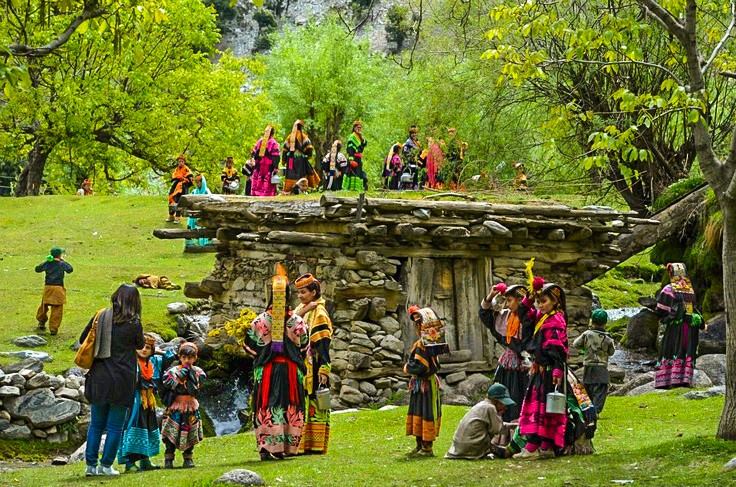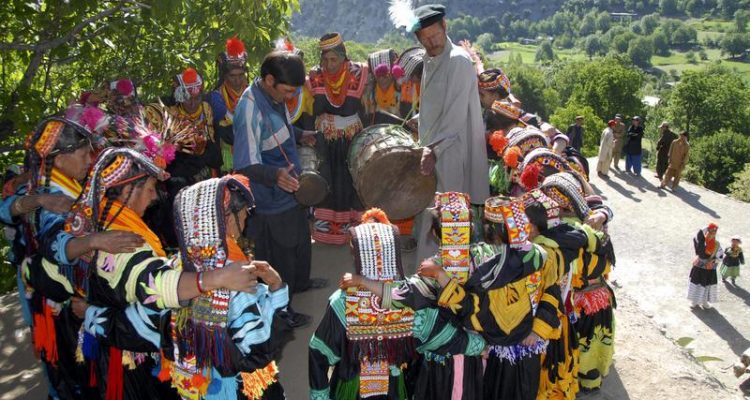Chilam Joshi (Spring)
Chilam Joshi is a spring festival of Kalash which is celebrated in May to welcome spring and the fairies who according to their belief come down to the mountain.

Chilam Joshi festival starts at Rumbur valley and then moves on to other valleys of Kalash. In this festival, Kalashi people pray for the safeguard of their fields and animals before going to their fields and for this purpose they used to spread milk on their Gods. The unmarried Kalasha boys and girls during the festival choose their life partners. They announce their life partners name on the last day of the festival.
Uchal Festival (Autumn)
The Uchal festival is one of the cultural festivals celebrated by Kalasha tribe. The Uchal festival continues for many days moving from one village to another. Finally, the mega event of Uchal festival is at Bamburet.
The festival celebrates the annual harvesting with singing, dancing and paying homage to the nature for blessing them with good food and fruits. It is marked in the barley and wheat harvest season every year in August.

The people of Kalasha community prepare cornbread, buttermilk and cheese to celebrate the festival. In the festival, Kalash women and girls decorate their houses and the ceremony is accompanied by dancing and rhythmical chant to the drumbeat.
They wear their traditional black robes, ornate cowries shelled headdresses and adorned with coloured necklaces and dance in a circle. During the festival, prayers and processions are held at a high plateau outside the village in Balangkuru where the long night of dancing begins.
Choimus Festival (Mid Winter)
Choimus Festival is the festival of purification celebrated by the Kalashas. People of dance in giant circles around bonfires and chanting in mesmerising repetitions – with just a drum beat accompanying the voices. The girls wear intricate costumes with dresses made of cowery shells, coins and beads with intricate hair braiding and headwear. The heavy headdress weighing several pounds is presented to the girl by her uncle. Other jewellery includes necklaces made from apricot kernels, a traditional gift during Choimus. Women often paint their faces with ink (replacing earlier customs of facial tattooing). Single woman are expected to find themselves a husband during these festivals.

Just before the main festival, seasonal foods are offered to the ancestral spirits and a kotik, light for the ancestors, is lit. After this ritual the food, considered impure, is offered to the elderly women to be eaten.
During the festival, purity is paramount and celibacy is enforced throughout the days of the event so all the people will be in pure mind when Balomain visit the valley. All the people must be cleansed in a ritual bathing the week before the festival begins. During the men’s purification ceremony, they must not sit down at all during the day and at night the blood of a sacrificed goat is sprinkled on their faces. Special bread is eaten cooked away from the main village which is prepared by men only during the purification ceremony. Other bread called jaou or choimus breadis prepared for the festival which is stuffed with crushed walnuts and goats cheese.
Special dance halls exist for the purpose of dancing at festivals. They are decorated with ornate carved wooden pillars and goat-like figurines. The music and dance is a performance of set songs: the Cha or clapping song is the simplest song with a lilting dance, sung by the elders, with an energetic round dance and the women cry like goats. The drajahilak songs are long and slow, sometimes one song can last up to 2 hours and it is a kind of solo and chorus using improvisation and variation techniques. The Dushak combines the styles of Cha and Drajahilak, presenting both traditional songs and new compositions.The dancing involves side stepping, fast and rhythmical.
During the festival prayers, a procession is made to a high plateau outside of the village in Balanguru where the long night of dancing begins. The festivals continues for many more day moving on to different locations within the valleys.


What an amazing culture and attire. I really want to visit pakistan one day.